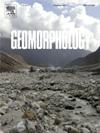Impact of vegetation cover on hydro-sedimentary fluxes in the marly badlands of the Southern Alps (Draix-Bléone Critical Zone Observatory, SE France)
IF 3.1
2区 地球科学
Q2 GEOGRAPHY, PHYSICAL
引用次数: 0
Abstract
Located in the Southern Alps, the Terres Noires region is characterized by highly erodible and poorly permeable soils. This, combined with the steep slopes and short, intense rains of the Mediterranean climate results in the formation of highly rilled/gullied surfaces known as badlands. Anthropogenic activities such as deforestation have exacerbated runoff and erosion on these surfaces. The aim of this study is to characterize the influence of vegetation cover on the multiscale temporal hydro-sedimentary functioning (and its controlling factors) of badlands. For this purpose, an approach combining the analysis of field data and the use of the physics-based model CAESAR-Lisflood was developed. The results indicate that the forested surfaces exhibit greater dampening of the fluxes than the bare surfaces, especially in the short term. The lower hydrological reactivity of the forested areas compared to the bare areas can be attributed to the higher retention and percolation capacity of the forested soils. Additionally, vegetation impedes the formation of regolith and the physical disaggregation of particles by regulating humidity and temperature fluctuations. With regard to predictive capacity, the model provides reliable estimates of the hydrologic balance of the catchments. However, there is potential for improvement in the calibration process to better represent the temporal dynamics of water flows and the amplitude and variability of sediment fluxes. The results of this study can serve as a basis for the development of water and soil management strategies in the badlands of the Southern Alps.
求助全文
约1分钟内获得全文
求助全文
来源期刊

Geomorphology
地学-地球科学综合
CiteScore
8.00
自引率
10.30%
发文量
309
审稿时长
3.4 months
期刊介绍:
Our journal''s scope includes geomorphic themes of: tectonics and regional structure; glacial processes and landforms; fluvial sequences, Quaternary environmental change and dating; fluvial processes and landforms; mass movement, slopes and periglacial processes; hillslopes and soil erosion; weathering, karst and soils; aeolian processes and landforms, coastal dunes and arid environments; coastal and marine processes, estuaries and lakes; modelling, theoretical and quantitative geomorphology; DEM, GIS and remote sensing methods and applications; hazards, applied and planetary geomorphology; and volcanics.
 求助内容:
求助内容: 应助结果提醒方式:
应助结果提醒方式:


